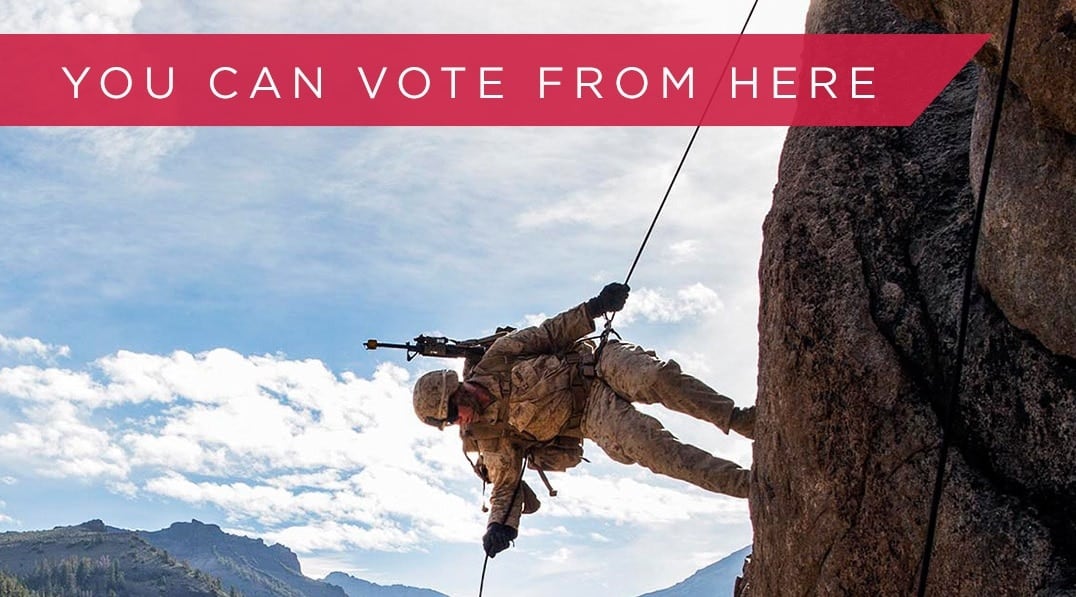The number of military and overseas voters who have downloaded voting forms from DoD's voting assistance website has decreased by 18 percent compared to the 2012 presidential election, according to Defense Department officials.
Officials aren't sure what to make of that drop-off, and whether it represents a trend in this year's voting among the military and overseas citizens communities. It may be related to more online voting options from the states -- allowing voters to register and request ballots online directly from local election officials.
All year, DoD and service officials have been publicizing the resources available to help service members and families register to vote and request an absentee ballot. Voters can go directly to their local election officials, and DoD's Voting Assistance Program site, FVAP.gov, can help direct voters to the right place. Or, voters can use the Federal Post Card Application, which is available at FVAP.gov or from unit voting assistance officers or installation voting assistance offices.
Within two weeks, the message to troops and families will change, urging voters to return their absentee ballots. Officials will also tell voters that if they haven't received their state absentee ballot by 30 days before the election, they should use the backup Federal Write-In Absentee Ballot. Election Day is Nov. 8.
As of Sept. 1, absentee ballots of overseas military members and family members are given special treatment. Overseas military postal clerks attach the Express Mail Service label 11-DoD, which expedites delivery to local election officials. The label also allows the voter to track the ballot until final delivery to local election officials.
Officials have sent out monthly emails to active-duty members as one part of their outreach effort. And for the first time, FVAP has been conducting a direct mail campaign, sending voting reminder mailings to active-duty members; another mailing scheduled for Sept. 22. Mailings to known addresses of military spouses were sent Sept. 2, with another scheduled for Sept. 15. Overseas citizens mailings were sent Aug. 30, with another scheduled for Sept. 15.
"My layman’s assessment is that an 18 percent drop is a fairly significant drop by any standard," said Mike Turner, executive director of the Military Officers Association’s Military Family Initiative. "This is just as engaging an election as 2012 was."
But it’s not clear whether the 18 percent reduction is significant, said Katherine Roddy, a spokeswoman for the DoD Federal Voting Assistance Program. After the election, when FVAP does a survey of military members and spouses, it will be able to gain insight into their voting patterns, she said.
There are also fewer active-duty personnel in 2016 than there were in 2012, and fewer deployed personnel.

Instagram is one tool the Federal Voter Assistance Program is using to publicize its services.
Photo Credit: FVAP via Instagram
Downloading the FPCA from the FVAP.gov site is just one way military and overseas voters register to vote and get their absentee ballot. Some statistics show an increase in the use of the state or local forms for requesting a ballot. In 2014, 44 percent of active-duty members responding to a question in the Defense Manpower Data Center post-election survey said they used a state or local form to request an absentee ballot, and 30 percent used the FPCA. That's a turnaround from 2012, when 46 percent said they used the FCPA and 40 percent used a state or local form to request a ballot.
"Overall, the FPCA downloads for this year feel like an incomplete picture of what’s happening, or where voters might be going to request their absentee ballots," said Stacey Scholl, elections program associate for the Democracy Fund. "Democracy Fund is hopeful that states will continue to innovate and provide resources for their voters."
The pace is also likely to pick up. By the end of the election cycle in 2012, about 883,000 FPCAs were downloaded, compared to 317,844 from Jan. 1 through Aug. 25, 2012. Through Aug. 27 this year, there were 261,181 FCPA downloads.
This year, FVAP, Military Postal Service Agency, U.S. Postal Service Agency and six local election jurisdictions are conducting a pilot program that will test full tracking of the life of a ballot -- from the time it leaves the local election office, through delivery to the military voter, and back to the local election office. It will track ballots through both the domestic postal system and the military postal system. "It will enable increased customer service for voters and will provide valuable research data to help identify areas for improvement," said Roddy.
The Military Ballot Tracking Pilot ballots will be shipped as parcels using Priority Mail, by no later than Sept. 24.
That’s 45 days before the election, and by law, all absentee ballots must be sent by that date to all military members, military family members and overseas citizens who have requested a ballot from their local election officials.
Karen has covered military families, quality of life and consumer issues for Military Times for more than 30 years, and is co-author of a chapter on media coverage of military families in the book "A Battle Plan for Supporting Military Families." She previously worked for newspapers in Guam, Norfolk, Jacksonville, Fla., and Athens, Ga.





